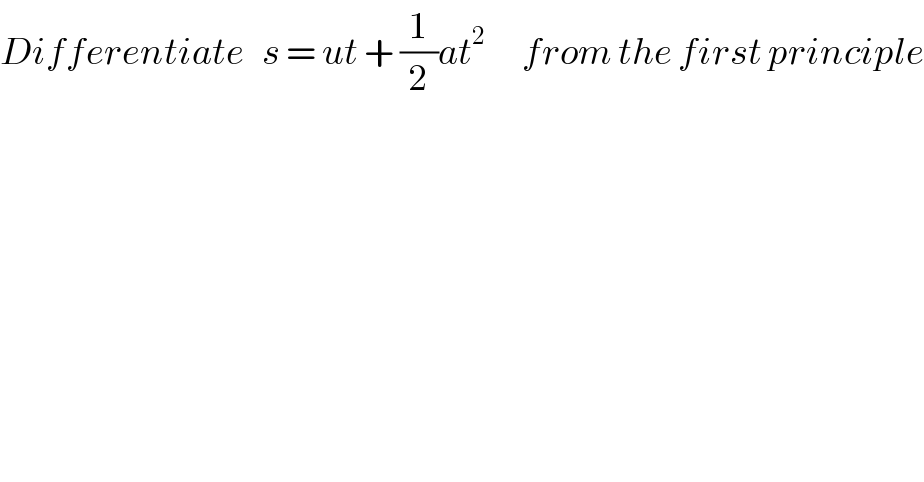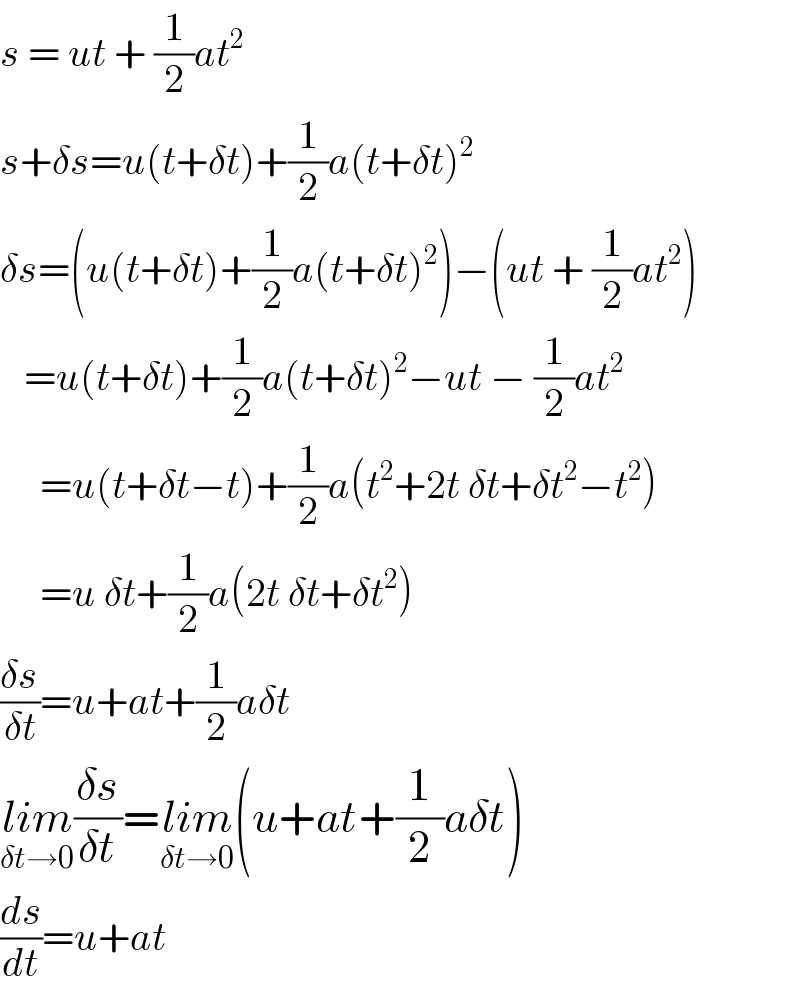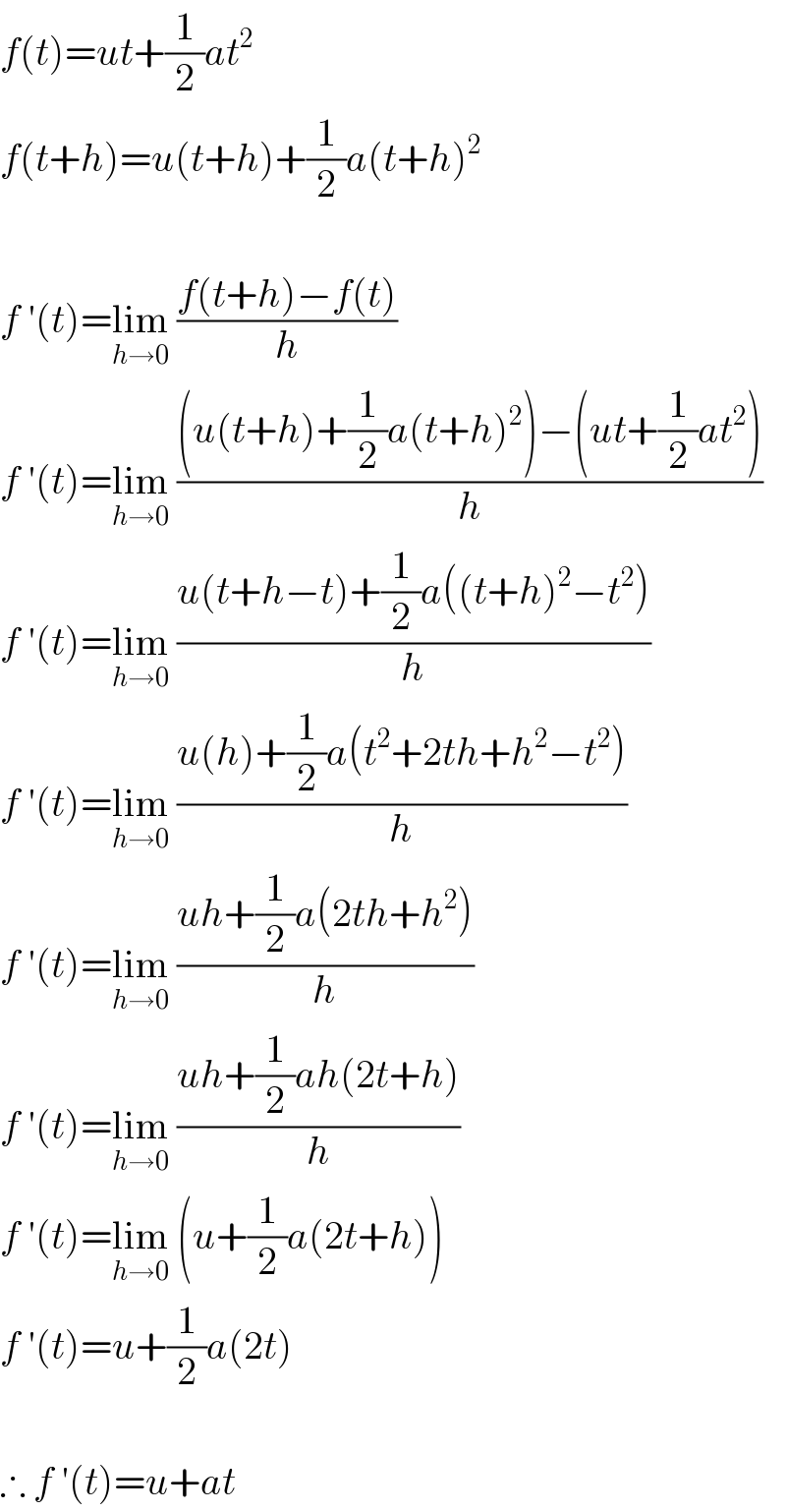
Question Number 6152 by sanusihammed last updated on 16/Jun/16

$${Differentiate}\:\:\:{s}\:=\:{ut}\:+\:\frac{\mathrm{1}}{\mathrm{2}}{at}^{\mathrm{2}} \:\:\:\:\:\:{from}\:{the}\:{first}\:{principle} \\ $$$$ \\ $$
Answered by Rasheed Soomro last updated on 16/Jun/16

$${s}\:=\:{ut}\:+\:\frac{\mathrm{1}}{\mathrm{2}}{at}^{\mathrm{2}} \:\:\: \\ $$$${s}+\delta{s}={u}\left({t}+\delta{t}\right)+\frac{\mathrm{1}}{\mathrm{2}}{a}\left({t}+\delta{t}\right)^{\mathrm{2}} \\ $$$$\delta{s}=\left({u}\left({t}+\delta{t}\right)+\frac{\mathrm{1}}{\mathrm{2}}{a}\left({t}+\delta{t}\right)^{\mathrm{2}} \right)−\left({ut}\:+\:\frac{\mathrm{1}}{\mathrm{2}}{at}^{\mathrm{2}} \right) \\ $$$$\:\:\:={u}\left({t}+\delta{t}\right)+\frac{\mathrm{1}}{\mathrm{2}}{a}\left({t}+\delta{t}\right)^{\mathrm{2}} −{ut}\:−\:\frac{\mathrm{1}}{\mathrm{2}}{at}^{\mathrm{2}} \\ $$$$\:\:\:\:\:={u}\left({t}+\delta{t}−{t}\right)+\frac{\mathrm{1}}{\mathrm{2}}{a}\left({t}^{\mathrm{2}} +\mathrm{2}{t}\:\delta{t}+\delta{t}^{\mathrm{2}} −{t}^{\mathrm{2}} \right) \\ $$$$\:\:\:\:\:={u}\:\delta{t}+\frac{\mathrm{1}}{\mathrm{2}}{a}\left(\mathrm{2}{t}\:\delta{t}+\delta{t}^{\mathrm{2}} \right) \\ $$$$\frac{\delta{s}}{\delta{t}}={u}+{at}+\frac{\mathrm{1}}{\mathrm{2}}{a}\delta{t} \\ $$$$\underset{\delta{t}\rightarrow\mathrm{0}} {{lim}}\frac{\delta{s}}{\delta{t}}=\underset{\delta{t}\rightarrow\mathrm{0}} {{lim}}\left({u}+{at}+\frac{\mathrm{1}}{\mathrm{2}}{a}\delta{t}\right) \\ $$$$\frac{{ds}}{{dt}}={u}+{at} \\ $$
Answered by FilupSmith last updated on 16/Jun/16

$${f}\left({t}\right)={ut}+\frac{\mathrm{1}}{\mathrm{2}}{at}^{\mathrm{2}} \\ $$$${f}\left({t}+{h}\right)={u}\left({t}+{h}\right)+\frac{\mathrm{1}}{\mathrm{2}}{a}\left({t}+{h}\right)^{\mathrm{2}} \\ $$$$ \\ $$$${f}\:'\left({t}\right)=\underset{{h}\rightarrow\mathrm{0}} {\mathrm{lim}}\:\frac{{f}\left({t}+{h}\right)−{f}\left({t}\right)}{{h}} \\ $$$${f}\:'\left({t}\right)=\underset{{h}\rightarrow\mathrm{0}} {\mathrm{lim}}\:\frac{\left({u}\left({t}+{h}\right)+\frac{\mathrm{1}}{\mathrm{2}}{a}\left({t}+{h}\right)^{\mathrm{2}} \right)−\left({ut}+\frac{\mathrm{1}}{\mathrm{2}}{at}^{\mathrm{2}} \right)}{{h}} \\ $$$${f}\:'\left({t}\right)=\underset{{h}\rightarrow\mathrm{0}} {\mathrm{lim}}\:\frac{{u}\left({t}+{h}−{t}\right)+\frac{\mathrm{1}}{\mathrm{2}}{a}\left(\left({t}+{h}\right)^{\mathrm{2}} −{t}^{\mathrm{2}} \right)}{{h}} \\ $$$${f}\:'\left({t}\right)=\underset{{h}\rightarrow\mathrm{0}} {\mathrm{lim}}\:\frac{{u}\left({h}\right)+\frac{\mathrm{1}}{\mathrm{2}}{a}\left({t}^{\mathrm{2}} +\mathrm{2}{th}+{h}^{\mathrm{2}} −{t}^{\mathrm{2}} \right)}{{h}} \\ $$$${f}\:'\left({t}\right)=\underset{{h}\rightarrow\mathrm{0}} {\mathrm{lim}}\:\frac{{uh}+\frac{\mathrm{1}}{\mathrm{2}}{a}\left(\mathrm{2}{th}+{h}^{\mathrm{2}} \right)}{{h}} \\ $$$${f}\:'\left({t}\right)=\underset{{h}\rightarrow\mathrm{0}} {\mathrm{lim}}\:\frac{{uh}+\frac{\mathrm{1}}{\mathrm{2}}{ah}\left(\mathrm{2}{t}+{h}\right)}{{h}} \\ $$$${f}\:'\left({t}\right)=\underset{{h}\rightarrow\mathrm{0}} {\mathrm{lim}}\:\left({u}+\frac{\mathrm{1}}{\mathrm{2}}{a}\left(\mathrm{2}{t}+{h}\right)\right) \\ $$$${f}\:'\left({t}\right)={u}+\frac{\mathrm{1}}{\mathrm{2}}{a}\left(\mathrm{2}{t}\right) \\ $$$$ \\ $$$$\therefore\:{f}\:'\left({t}\right)={u}+{at} \\ $$
Commented by FilupSmith last updated on 16/Jun/16

$$\mathrm{added}\:\mathrm{this}\:\mathrm{as}\:\mathrm{a}\:\mathrm{different}\:\mathrm{notation} \\ $$
Commented by sanusihammed last updated on 16/Jun/16

$${Thank}\:{you}\: \\ $$
